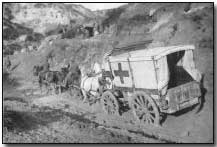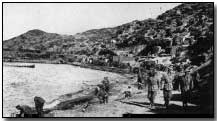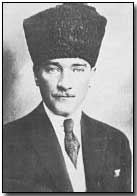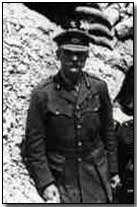Battles - The Gallipoli Landings at Helles and Anzac Cove, 1915
 February
and March
1915 saw a series of three purely naval assaults upon the Dardanelles
Straits by a combined British and French force led by
Sir Sackville
Carden and, latterly,
Sir John de
Robeck. All ended in failure: all were the brainchild of British
First Lord of the Admiralty
Winston
Churchill. The failure of the naval offensive ultimately claimed
the careers of Churchill, First Sea Lord Admiral
John Fisher
(whose resignation brought Churchill down with him) and French naval
minister Jean
Augagneur.
February
and March
1915 saw a series of three purely naval assaults upon the Dardanelles
Straits by a combined British and French force led by
Sir Sackville
Carden and, latterly,
Sir John de
Robeck. All ended in failure: all were the brainchild of British
First Lord of the Admiralty
Winston
Churchill. The failure of the naval offensive ultimately claimed
the careers of Churchill, First Sea Lord Admiral
John Fisher
(whose resignation brought Churchill down with him) and French naval
minister Jean
Augagneur.
Thus what began as a 'demonstration' of naval force against Turkish fortresses in the Dardanelles Straits claimed a number of high profile political scalps. Rather than call off the endeavour in failure however the British and - somewhat more reluctantly, the French - government decided to press forward with a combined naval/ground expedition, the whole to be led by Lord Kitchener's former protégé, the newly-appointed Sir Ian Hamilton.
Hamilton was assigned a force of 75,000 men by Kitchener and a further 18,000 French colonial troops were added on 10 March. Facing him were 84,000 Turkish troops - amounting to six divisions - led by attached German officer Liman von Sanders.
 When
Liman was given the task of organising the Turkish defence of the peninsula
on 25 March he was initially fearful that the grave shortage of ammunition
allied with poor organisation and lack of men - just 20,000 were then
available - would leave the Turkish position open to a successful invasion.
When
Liman was given the task of organising the Turkish defence of the peninsula
on 25 March he was initially fearful that the grave shortage of ammunition
allied with poor organisation and lack of men - just 20,000 were then
available - would leave the Turkish position open to a successful invasion.
He need not have feared however. Hamilton inherited an equally if not more disorganised operation. Quite aside from being unsure what he was expected to achieve the courteous Hamilton set sail from England minus his staff and with the absence of informed intelligence data concerning the Turkish defences.
Added to Hamilton's woes were extended delays in arranging for the receipt of his ground troops. Those that arrived early at Mudros - on the island of Lemnos, rear headquarters for the operation - were promptly despatched to Egypt pending the arrival of further men and sufficient equipment in the necessary transports.
In all the expedition took in excess of five weeks to arrive on the peninsula, leaving Liman with adequate time to prepare his defences. Nevertheless Hamilton still held one notable advantage: the site and date of the invasion was to be of his choosing. Liman could only carefully apportion his forces to likely strategic locations and hope for the best.
 Liman
chose to site two of his six divisions around Bulair and the Gulf of Saros,
on the neck of the peninsula and regarded as the most probable invasion
target. A further two divisions were stationed at Besika Bay on the
Asian coast close to the Allied fleet. Liman placed a single division
under Colonel
Mustafa Kemal at the peninsula's southernmost tip; and the final
division was placed on standby as a reserve force in the heart of the
peninsula.
Liman
chose to site two of his six divisions around Bulair and the Gulf of Saros,
on the neck of the peninsula and regarded as the most probable invasion
target. A further two divisions were stationed at Besika Bay on the
Asian coast close to the Allied fleet. Liman placed a single division
under Colonel
Mustafa Kemal at the peninsula's southernmost tip; and the final
division was placed on standby as a reserve force in the heart of the
peninsula.
In the event the landings took place at two locations on 25 April 1915, Cape Helles and Ari Burnu (shortly afterwards renamed Anzac Cove). These were selected by Hamilton on the basis that the capture of these would assist the progress of the Allied battlefleet along the Straits.
The landing at Cape Helles on the peninsula's southern tip, which was badly mismanaged by Aylmer Hunter-Weston, was at five locations ('Y', 'X', 'W', 'V' and 'S' Beaches) and consisted of 35,000 men. 15km further along the Aegean coast the Australian and New Zealand Corps - Anzacs - comprising 17,000 largely untried men were landed at Ari Burnu ('Z Beach'), 1.5km north of Gaba Tepe (where the landing was actually intended). William Birdwood's management of the Anzac's landing was markedly better than Hunter-Weston.
Meanwhile part of the French force, a division under General d'Amade, acted as a diversion by successfully landing on the Asiatic shore at Kum Kale and taking possession. Also serving as diversion were the remainder of the British force which continued further north to Bulair, leading Liman to believe that a further invasion site was planned. Part of the French force also feigned a landing at Besika Bay.
 Indeed
Liman required two days until he correctly ascertained the true key invasion
sites and was able to respond accordingly. Until this time a single
Turkish division served to defend against Hamilton's force at Cape Helles
and Ari Burnu.
Indeed
Liman required two days until he correctly ascertained the true key invasion
sites and was able to respond accordingly. Until this time a single
Turkish division served to defend against Hamilton's force at Cape Helles
and Ari Burnu.
For all that the Turkish defending force was relatively weak, it performed remarkably well in holding back Hunter-Weston's force of 35,000 at Cape Helles. Of the five landing sites two ('W' and 'V' Beaches) came under heavy Turkish machine gun fire. The remaining three sites were quickly secured, yet inexplicably Hunter-Weston chose not to press forward and attack the remainder of the defence force, seemingly content with his initial gains. He could however find recourse in Hamilton's vague directive stating that the actual landings be given highest priority rather than further advances.
At Ari Burnu however Birdwood found his entire landing unopposed, and he took full advantage by pushing up in the direction of the Chunk Bair height which overlooked the entire peninsula. However a resolute Turkish defence force hastily assembled by Colonel Kemal halted the Anzac advance, eventually forcing Birdwood's men back to the beaches by the day's close.
The Allied position by the end of 25 April was not therefore an encouraging one. Landings had been achieved at Cape Helles and Ari Burnu, but advances had not been feasible (or, in Hunter-Weston's case, attempted) at either. Turkish troops quickly surrounded the Allied force and in addition were in possession of the heights above the beachheads. Hamilton's force, finding itself short of necessary ammunition, was further handicapped by the requirement to use its artillery sparingly.
 Yet
Liman's Turkish force similarly found itself unable to advance, finding it
difficult to push Hamilton's solidly entrenched men back into the sea.
Stalemate set in, along with a particularly unpleasant form of trench
warfare similar to that experienced on the Western Front.
Yet
Liman's Turkish force similarly found itself unable to advance, finding it
difficult to push Hamilton's solidly entrenched men back into the sea.
Stalemate set in, along with a particularly unpleasant form of trench
warfare similar to that experienced on the Western Front.
Three days after the 25 April landings Hamilton determined to extend the Allied position in the south with attacks directed towards Krithia to which the Turkish force at Helles had retired. Unduly optimistic in its aims three successive operations were launched upon Krithia by Hunter-Weston: all were thrown back by Liman's increasingly effective Turkish defence force.
Hamilton's overall losses were heavy. Up to one third of his force had suffered casualties. He consequently requested reinforcements from Kitchener in London. The latter ultimately obliged but not without first having to face a barrage of criticism from British and French commanders on the Western Front adamant that reserves could not be spared from the struggle in the west.
Eventually reinforced to twelve divisions Hamilton's next move came on 6 August 1915 with a further landing at Suvla Bay intended to link up with Birdwood at Anzac Cove and sweep across the peninsula.
To view maps detailing the progress of the Gallipoli campaign click here; and here; and here; and here.
Photographs courtesy of Photos of the Great War website
"Harry Tate" was the nickname given by British pilots to the R.E.8 aircraft
- Did you know?
